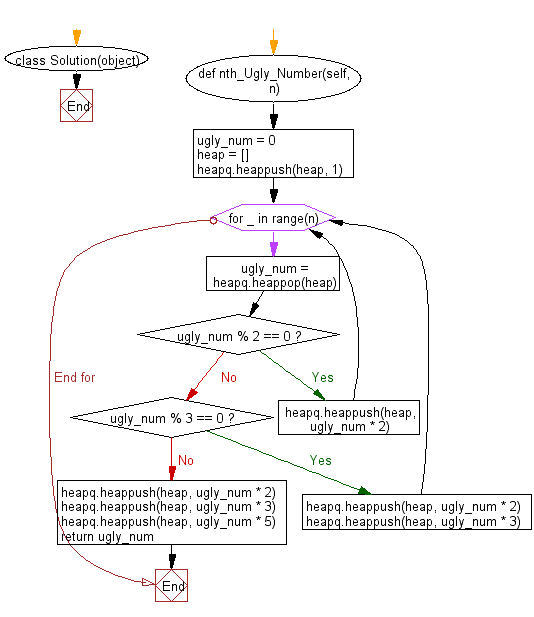Python: Find the nth ugly number using Heap queue algorithm
Python heap queue algorithm: Exercise-18 with Solution
Write a Python program to find the nth ugly number using Heap queue algorithm.
Ugly numbers are positive numbers whose only prime factors are 2, 3 or 5. The sequence 1, 2, 3, 4, 5, 6, 8, 9, 10, 12, ... shows the first 10 ugly numbers.
Note: 1 is typically treated as an ugly number.
Sample Solution:
Python Code:
import heapq
class Solution(object):
#:type n: integer
#:return type: integer
def nth_Ugly_Number(self, n):
ugly_num = 0
heap = []
heapq.heappush(heap, 1)
for _ in range(n):
ugly_num = heapq.heappop(heap)
if ugly_num % 2 == 0:
heapq.heappush(heap, ugly_num * 2)
elif ugly_num % 3 == 0:
heapq.heappush(heap, ugly_num * 2)
heapq.heappush(heap, ugly_num * 3)
else:
heapq.heappush(heap, ugly_num * 2)
heapq.heappush(heap, ugly_num * 3)
heapq.heappush(heap, ugly_num * 5)
return ugly_num
n = 7
S = Solution()
result = S.nth_Ugly_Number(n)
print("7th Ugly number:")
print(result)
n = 10
result = S.nth_Ugly_Number(n)
print("\n10th Ugly number:")
print(result)
Sample Output:
7th Ugly number: 1 10th Ugly number: 1
Flowchart:
Visualize Python code execution:
The following tool visualize what the computer is doing step-by-step as it executes the said program:
Python Code Editor:
Have another way to solve this solution? Contribute your code (and comments) through Disqus.
Previous: You are given two integer arrays sorted in ascending order and an integer k. Write a Python program to find k number of pairs (u, v) which consists of one element from the first array and one element from the second array using Heap queue algorithm.
Next: Write a Python program to print a heap as a tree-like data structure.
What is the difficulty level of this exercise?
Test your Python skills with w3resource's quiz
Python: Tips of the Day
The get() method on Python dicts and its "default" arg
Example:
# The get() method on dicts
# and its "default" argument
name_for_userid = {
382: "Owen",
590: "Eddie",
951: "Pepe",
}
def greeting(userid):
return "Hi %s!" % name_for_userid.get(userid, "Hello")
print(greeting(382))
"Hi Owen!"
print(greeting(333333))
"Hi Hello!"
Output:
Hi Owen! Hi Hello!
- New Content published on w3resource:
- Scala Programming Exercises, Practice, Solution
- Python Itertools exercises
- Python Numpy exercises
- Python GeoPy Package exercises
- Python Pandas exercises
- Python nltk exercises
- Python BeautifulSoup exercises
- Form Template
- Composer - PHP Package Manager
- PHPUnit - PHP Testing
- Laravel - PHP Framework
- Angular - JavaScript Framework
- React - JavaScript Library
- Vue - JavaScript Framework
- Jest - JavaScript Testing Framework

